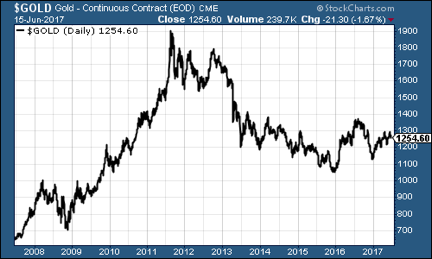
I’m going to step away from politics this week to look at the people who really run the financial world (well, for now at least – the pendulum is swinging) central banks.
There’s been a lot of movement from central banks this week – the US Federal Reserve, the Bank of England and the Bank of Japan have all given their views on interest rates.
The Fed was a little more hawkish than expected (ie more inclined to raise rates); the Bank of England a lot more hawkish (in that it nearly voted to raise rates); and the Bank of Japan seemed content to meander on with quantitative easing despite being fairly pleased with the way the economy is going.
The overall tone is one of optimism, which is pretty much the direct opposite of our current political tone.
So how has that had an impact on our six charts that matter?
Gold
The more hawkish tone from the Fed had the expected effect on gold, which has failed to breach the $1,300 mark and slipped on the week back to $1,255.
Gold likes it when “real” interest rates (ie interest rates after inflation) are falling. Now, people are getting worried again that inflation is weak (in the US; not the UK, obviously), reflecting weak economic growth, and yet the Fed is still keen to raise interest rates on schedule.
That means that real interest rates are rising rather than falling. In turn, that’s bad news for gold because it doesn’t yield anything.
In the longer run I firmly expect the Fed to fall behind inflation and I’d hold on to your gold regardless of what it says, pretty much. But it shows you how the thinking in the market is swinging. And that’s important – because that’s also what helps you to understand which events the market might end up being surprised by.
US dollar index
This picked up a little this week, helped by the Fed, but it’s not much higher than it was last week. It’ll be interesting to see if this could be a (temporary) turning point for the dollar though. If it is, expect Donald Trump to try to talk it down, as that’s one of his only options for boosting the economy at the moment.
US Treasury bonds
Interestingly, ten-year US Treasury bonds continued to fall despite the Fed threatening higher interest rates. That’s probably because right now the market is more worried about the Fed being too trigger-happy than about it waiting for too long.
Copper
Copper is continuing to wander aimlessly. The market can’t quite figure out if reflation is still on or if we’re on the edge of another deflationary scare (or a full-blown deflationary panic).
Bitcoin
The crypto currency suffered a rare down week, but the volatility is only to be expected when something looks this frothy. The wider crypto-currency field is also becoming more interesting, in that bitcoin is no longer the full picture. We’ll talk more about this in a future issue of MWU.
Source: bitcoincharts.com
US jobless claims
This isn’t directly affected by the Fed’s interest rate decisions – it’s more like the other way around. Strong employment growth points to strong wage growth. At the moment we’ve got one – strong employment – but not the other, although there’s an interesting gauge from the Atlanta Fed that suggests US wage inflation might be healthier than it looks, running at about 3.5% a year and climbing. I’m not sure on how much to trust that one yet but I’m certainly keeping an eye on it.
In any case, one of the most timely employment indicators is the weekly US jobless claims total.
David Rosenberg of Gluskin Sheff reckons this is a valuable leading indicator. When the figure hits a “cyclical trough” (as measured by the four-week moving average), a stock market peak is not far behind, and a recession follows about a year later.
This week, claims fell to 237,000. That was lower than expected (in other words, the picture for employment looks healthier than expected) and it’ll drag the four-week moving average – which is still near its lowest level since April 1973 – further down.